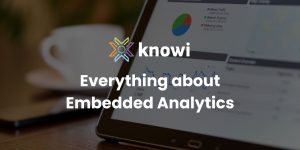Ever felt overwhelmed by the sheer amount of data at your fingertips, wishing for a simpler way to make sense of it all? If this sounds familiar, then know that you’re not alone. And that there’s an easier way, a revolutionary solution, that will set you soaring on the track to success.
Enter embedded analytics—a game-changer in the realm of business intelligence. But why is this integration so revolutionary? Consider the vast amounts of data generated every second in today’s digital world. The true value of this data lies not in its volume but in its potential to drive transformative business decisions. Embedded analytics bridges the gap between raw data and actionable insights, ensuring that every team member, regardless of their technical expertise, can make informed decisions swiftly.
However, as with any powerful tool, there are best practices to follow and challenges to navigate. This article delves deep into the world of embedded analytics, to offer a comprehensive overview, highlight best practices to maximize its potential, and address the challenges that businesses may encounter along the way.
What is Embedded Analytics?
Embedded analytics refers to the integration of analytical capabilities within the business applications or operational processes that you already use. This integration facilitates real-time data analysis within the native environment of the application, eliminating the need to toggle between different systems or platforms. It combines the operational capabilities of a business application and supercharges it with analytical prowess.
For instance, within a financial software platform, embedded analytics can provide real-time trend analysis, predictive forecasting, and actionable insights based on historical data, all without the user having to leave the platform. Consider too, the practical application within a Customer Relationship Management (CRM) system. Traditionally, sales professionals would need to extract reports or access a separate analytics module to discern a client’s purchasing trajectory or to forecast potential buying behavior. With the advent of embedded analytics, these insights are integrated directly into the CRM interface. Upon accessing a client’s profile, predictive algorithms might make optimal product recommendations, informed by the client’s past interactions and broader market analytics.
Embedded analytics transforms passive data into proactive insights, ensuring that decision-making is always backed by real-time, contextual data. It makes data-driven insights not only accessible and actionable but streamlined within the operational workflow.
What are the Benefits of Embedded Analytics?
In today’s data-driven landscape, the ability to swiftly harness insights is indispensable, and can supercharge the performance of your internal platforms and portals, as well as your customer-facing products.
Internal Platforms and Portals
In the intricate web of today’s business operations, embedded analytics are a catalyst like no other, driving efficiency and informed decision-making within internal platforms and portals.
- Boosting Productivity and Operational Effectiveness
By embedding analytics directly into internal tools available for all teams and users, you can eliminate the need to toggle between business applications and analytics tools. This single source of data ensures users can devote more time to crucial tasks, which improves productivity.
- Enhancing Data-Driven Decision Making
Providing internal teams with easily digestible, logically presented data ensures that informed decisions are made swiftly and confidently.
Customer-Facing Products
In the realm of customer-facing products, embedded analytics not only amplifies user experience but also carves out pivotal insights that can guide product development and marketing strategies.
- Accelerating Time-to-Market
The integration of embedded analytics can significantly reduce the development cycle by providing ready-to-use analytics functionalities, thereby facilitating a quicker product launch without the necessity of building analytics platforms from scratch.
- Securing a Competitive Edge
Using embedded analytics enables businesses to glean and apply product and audience insights effectively and promptly, ensuring you maintain a strategic advantage while competitors are still navigating through the embedded BI learning curve.
- Product Differentiation
Knowi steps into the spotlight here by enabling businesses to create a remarkable embedded analytical experience for customers. With options for white-label embedding and CSS customization, Knowi ensures your analytics seamlessly integrate into existing applications, to enhance your product and uplift customer satisfaction.
- Amplifying ROI on Customer-Facing Products
Upselling embedded analytics as a premium feature in customer-facing products not only enhances user experience but also opens up new revenue streams, thereby boosting ROI.
Embedded analytics, extends beyond a mere feature—it is a transformative tool, systematically redefining product value, strategically realigning market positioning, and methodically enhancing customer satisfaction.
Real World Examples of How Companies Are Using Embedded Analytics
Embedded analytics powers real-world solutions across a whole range of sectors. Let’s look at some examples of it in action:
- Starbucks: Personalized Customer Experience
Starbucks uses embedded analytics to offer a personalized experience to its customers. By analyzing purchase history and preferences, Starbucks’ mobile app provides tailored product recommendations. This both enhances the customer experience and drives additional sales. The app’s backend analytics also helps Starbucks in inventory management, predicting which products are likely to be in demand at specific locations and times.
- Netflix: Content Recommendation and Production
Netflix, the streaming giant, employs embedded analytics in its platform to provide real-time content recommendations to its users. By analyzing viewing patterns, search queries, and user ratings, Netflix offers tailored content suggestions, to ensure users spend more time on the platform. Netflix also uses these insights to make decisions about producing new content, identifying genres or themes that are currently popular among its users.
- Airbnb: Dynamic Pricing and Host Recommendations
Airbnb uses embedded analytics to assist hosts in setting competitive prices for their listings. By analyzing factors like location, amenities, time of year, and local events, Airbnb’s “Smart Pricing” feature suggests optimal pricing to maximize bookings. Additionally, hosts receive insights on how to improve their listings, based on guest feedback and comparison with similar successful listings.
These real-world business examples highlight how by integrating real-time data analysis into existing systems and processes, companies can derive actionable insights, optimize operations, and enhance user experiences.
Best Practices for Embedding Analytics: A Deep Dive
But how can organizations ensure they’re leveraging this tool to its fullest potential? As with any technological integration, there are best practices to follow to ensure both seamless implementation and optimal results. You should consider:
1. Security and Compliance
Maintaining the safety and integrity of data is paramount when embedding analytics into any application.
- User-Level Filters – Implement filters that restrict data access based on user roles or permissions. This ensures that users only see data relevant to their role, to maintain data privacy.
- SSO Implementation – Single Sign-On (SSO) allows users to access multiple applications with one set of credentials. This enhances security by reducing the number of passwords and potential breach points.
- Content Filters/Runtime Parameters – These filters ensure that the data being displayed is contextually relevant, based on real-time parameters or user-specific content settings.
Knowi’s Security Features – For a comprehensive understanding of security measures, Knowi provides detailed insights into their robust security protocols.
2. Data Integration Best Practices
The power of embedded analytics is best realized when it can seamlessly integrate with various data sources.
- Leverage Existing Infrastructure – Instead of overhauling current systems, it’s more efficient to integrate analytics into the existing data infrastructure.
- Support for Multiple Data Sources – An effective embedded analytics platform should be versatile, supporting various data sources, from Cloud Data Warehouses like Snowflake and Redshift to simpler formats like CSV files. Ideally, the platform should have pre-built connectors for common data sources to streamline integration.
3. User Focus
The end-user experience should be at the forefront of any embedded analytics implementation.
- Tailored Features – Analytics features should be customized based on specific customer requirements, to ensure relevance and usability.
- UI/UX Integration – The embedded analytics tool should seamlessly blend with the host application’s design, ensuring a consistent and intuitive user experience.
4. Scalability and Performance
As businesses grow, so do their data and user base. Embedded analytics solutions should be prepared to scale accordingly.
- Data Volume – The analytics tool should be capable of handling increased data volumes without compromising on performance.
- User Load – As more users access the system, the embedded analytics solution should maintain its responsiveness and efficiency.
By adhering to these best practices, businesses can ensure that their embedded analytics implementations are secure, user-friendly, and primed for growth.
Embedded Analytics with Knowi
At Knowi, we understand the complexities and demands of today’s data-driven world. That’s why Knowi is designed to seamlessly integrate powerful analytics into your applications. With Knowi you get instant insights, unparalleled security, and flexible integration options. Here are some of the features that make Knowi the gold standard in embedded analytics:
| For Your Customers or Business Teams | For Your Product Team |
| Self-Service Business Analytics | Eliminate ETL for Modern Data |
| Ad-hoc Analysis and Personalized Dashboards | Native Integration to NoSQL sources |
| Sharing Across Teams or Individuals | Blend Data from Multiple Sources on the Fly |
| Alerting via Email or Slack | White-label Option |
| Personalized Filters | Fully RESTful APIs for Fine-Grain Control Over User Permissioning and Assets |
| Data Export to CSV | Integrated Machine Learning to Support Predictive Analytics |
| Scheduled Email PDF Reports | Weekly Product Enhancements (cloud version) |
Ready to see it in action? Request a Demo today and let us show you the future of analytics!






